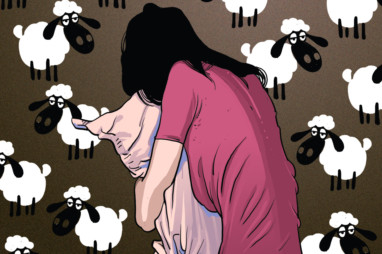
What do the following have in common: Vladimir Nabokov, Janis Joplin, the Lord Chancellor in Gilbert and Sullivan’s Iolanthe and the entire population of China? Respect (but no prizes) for guessing the answer: they can’t sleep.
Love, unrequited, robs the Lord Chancellor and the subjects of the chilly Chinese Princess Turandot, in Puccini’s ravishing aria-turned-football anthem, Nessun Dorma, of rest. “Why sleep, man? I might miss a party,” said Joplin at the end of Get It While You Can.
That inimitable voice — like a melodious young corncrake inexplicably raised by its feckless parents on a diet of Southern Comfort — is a testament to the artistic benefits of partying too much and sleeping too little. As for Nabokov, he really had it in for those of us who regularly manage a straight eight: “Sleep,” he remarked, “is the most moronic fraternity in the world, with the heaviest dues and the crudest rituals.” You get the general idea. Insomnia is inextricably associated with the noblest of human emotions: love, power, creativity and having a knock-down, can’t remember-a-thing-about-it good time. Plus being sensitive, obviously. Here in the dormouse corner, we like to argue that falling effortlessly into an instant dreamless sleep doesn’t mean that our feelings are of a lower order.
We are — Hallo clouds! Hallo, sky! — at ease with our Circadian rhythms, in tune with nature. But we are not, according to the International Association for the Study of Pain, as sensitive as our insomniac partners.
The association rounded up 10,000 subjects and made them put their hands in freezing water before interrogating them about their sleep habits.
Between pain and sleep
And guess what? It turns out that insomniacs are wimps. Let me rephrase that. According to Dr Borge Sivertsen of the Norwegian Institute of Public Health: “While there is clearly a strong relationship between pain and sleep... it is not clear exactly why this is the case.”
Perhaps Dr Sivertsen should extend his clinical research to those of us who live (and sleep) with insomniacs. We might be able to clear up a couple of things. For us, the “crude rituals” of sleep so despised by Vladimir Nabokov (what can he have meant? Putting on one’s nightie? Getting into bed?) dwindle to insignificance compared with the complicated nocturnal protocols of our sleepless partners. The lavender oil on the pillow, the jagged spikes of the iPhone sleep monitor, the lurid pharmacopoeia of pills, the detailed recitation — in answer to the phatic courtesy, “How did you sleep?” — of the busy activity of the small hours: the work accomplished, poems written and fatal maladies diagnosed with the help of Wikipedia.
Why would anyone want to sleep, when the troubled mind is such a romantic construct? Cast about for a poetic image of a decent night’s shut-eye, and what you come up with is Shakespeare’s WI-ish image of sleep as the knitter-up of the ravell’d sleeve of care? Well, really. Which would you rather identify with: a sexy hollow-eyed ame damnee - or a darned jumper?
Yet I note that insomniacs, for all their bold claims about the creative benefits of staying awake, long for nothing more than an innocent night’s unconsciousness. Andy Warhol and Sam Taylor-Wood both made films about the enigma of sleep, while Proust’s recently published correspondence with his noisy upstairs neighbour is a yearning prose poem in praise of elusive somnolence.
Insomnia may have the artistic edge, but when it comes to what Freud called the “royal road to the unconscious”, we stoic denizens of Nabokov’s “moronic fraternity” are the ones with privileged access.
— The Telegraph Group Limited, London 2015








